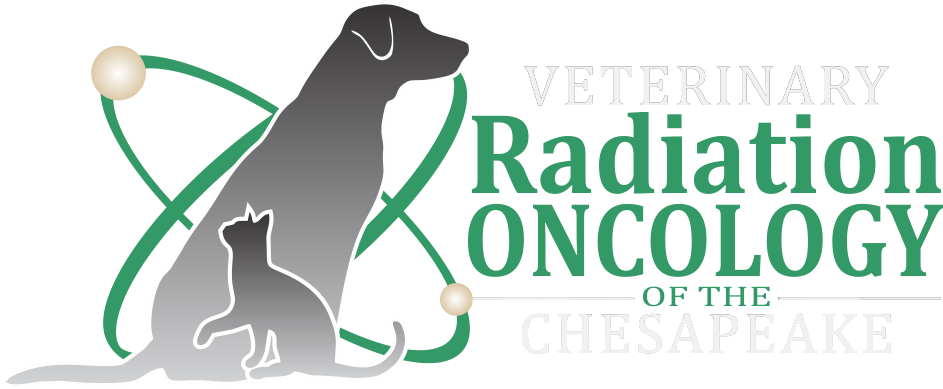Welcome to
Veterinary Radiation Oncology of the Chesapeake
Bringing Compassionate Veterinary Cancer Treatment to the Chesapeake Bay Area.
VROC’s Varian Trilogy Linear Accelerator System provides radiation treatment for pets with cancer using x-ray and multi-energy electron therapy. Intensity modulated radiation therapy (IMRT) computer treatment planning is used to precisely target the tumor and avoid treating surrounding normal tissue. Definitive or palliative therapy may be used for tumors that have indistinct margins or respond well to a more gradual administration of radiation.
Stereotactic treatments offer precision delivery of radiation with submillimeter accuracy which can minimize damage to surrounding healthy tissue and organs. It also allows for fewer treatments (1-5 vs. 15-20) and less anesthesia. This treatment protocol is ideal for single, well demarcated tumors
Multi-energy electron therapy may be used for tumors that have been mostly removed and lie close to the skin surface.
VROC's Varian Trilogy Linear Accelerator System can treat:
– Brain Tumors
– Nasal Tumors
– Bone Tumors
– Urogenital Tumors
– Non-resectable and Solitary Tumors
– Oral Tumors
– Lymphoma
– Non-resectable or Incompletely Excised Skin and Subcutaneous Tumors

Cutting-edge Treatment
We provide state-of-the-art, non-invasive treatment for localized forms of cancer.

Compassionate Care
Our compassionate experts provide precision treatment of tumors to enhance the quality of life for your pet.

Convenient Location
Our convenient Mid-Atlantic location within CVRC offers access to emergency and 24 hour care, neurosurgeons, medical oncologists and internist along with a variety of other specialties.
A Few FAQs
All pets will require advanced imaging, such as a CT scan or MRI in order to allow radiation to be targeted specifically to the tumor while avoiding critical surrounding normal tissue. Typically, there is a short period of time (1-3 days) that will then be used for the treatment planning process. This is accomplished with proprietary 3-dimensional treatment planning software, in which our radiation oncologist, Dr. Erica Buchanan will create a unique 3D plan using images obtained from the CT and/or MRI.
Radiation treatment provides a pain-free, non-surgical option for patients who have an inoperable or surgically complex tumors. The procedure is non-invasive, meaning there is no incision or cutting involved and therefore, no surgical recovery or discomfort. Often our clients will report that their pets seem more comfortable after treatment, likely due to reduction in the size of the tumor and less tumor related side effects.
Most radiation treatments are performed on an outpatient basis. Pets usually need to stay at the hospital for about 3 hours while their treatments are performed.
The side effects associated with are typically very minimal to absent, which is one of the great advantages of therapy over conventional radiation therapy. Any side effects will depend on the site of your pet’s tumor and what normal healthy organs surround the tumor. This will be discussed in detail when you meet with Dr. Erica Buchanan.
The effects of radiation treatment vary and may occur gradually and over time. The timeframe can range anywhere from days, months or years depending on your pet’s medical condition. Some tumors may reduce in size slower than others, while others may simply stop growing. Four to six months after radiation treatment, patients may have a repeat CT scan to clearly identify if the tumor treated was reduced in size.
The cost of radiation treatment varies based on the type and location of the tumor and number of fractions needed. Most veterinary insurance companies do cover a portion of radiation treatment depending on your pet’s policy. Please contact our office for more information about fees, interest-free payment options through Care Credit (www.carecredit.com) or how we can help you inquire about insurance benefits.
Unlike human radiation therapy, we cannot rely on an animal to stay perfectly still throughout the course of treatment. Anesthesia is unequivocally the least stressful option when it comes to ensuring no movement during radiation.
In most cases, your primary veterinarian will be able to point you in the proper direction. You also have the option to research online, and we’ve listed two different databases below for your convenience. You are always welcome to call, email, or submit an information request form (from our website) for assistance in locating the best Oncologist in your area.

For the Love of Pets
We're Here to Help
At VROC we treat pets with cancer using radiation (high energy x-rays).
We have the technology and equipment to precisely target the tumor with radiation while minimizing the dose to the surrounding normal tissue.
We have the ability to treat a variety of different tumors including brain tumors, nasal tumors, bladder tumors, and limb tumors.





